
Browse an alphabetical list of photographs. These historical images portray people, places, and events before, during, and after World War II and the Holocaust.
<< Previous | Displaying results 2151-2200 of 2641 for "Photo" | Next >>
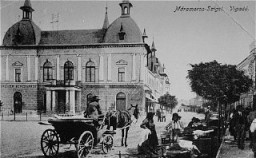
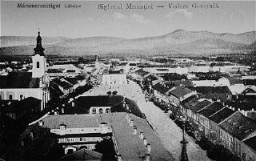
Sigmund Freud and daughter Anna in Paris, en route to exile in England. June 1938.
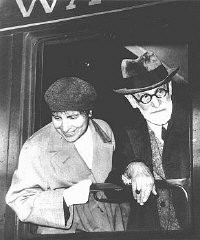
Members of the SA post signs demanding that Germans boycott Jewish-owned businesses. Berlin, Germany, April 1, 1933.
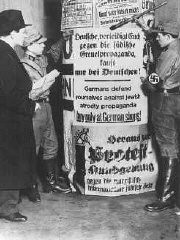
Tatsuro Matsuda, whose family owned the Wanto Co. grocery store, hung this sign in front of the store, Oakland, California, March 1942. The store was closed following orders for the evacuation of Americans of Japanese ancestry. Evacuees were forcibly deported to relocation centers.

A notice reads "Business closed by the police due to profiteering. Owner in protective custody at Dachau." Signed by police chief Heinrich Himmler. Munich, Germany, April or May 1933.
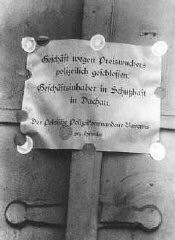
Nazi foreign minister Joachim von Ribbentrop (left), Soviet leader Joseph Stalin (center), and Soviet foreign minister Viacheslav Molotov (right) at the signing of the nonaggression pact between Germany and the Soviet Union. Moscow, Soviet Union, August 1939.
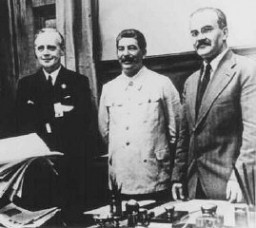
Soviet Foreign Minister Molotov signs the German-Soviet Pact. Joachim von Ribbentrop and Josef Stalin stand behind him, Moscow, Soviet Union, August 23. 1939.
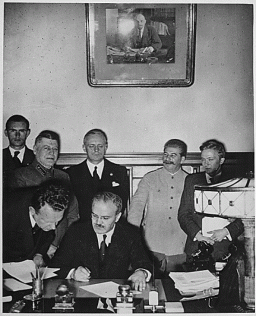
Bulgarian leader Bogdan Filov (standing) and German foreign minister Joachim von Ribbentrop (seated, center) during the signing of the Tripartite Pact. This treaty formally aligned Bulgaria with the Axis powers. Vienna, Austria, March 1, 1941.
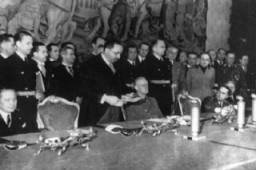
Soviet foreign minister Viacheslav Molotov signs the German-Soviet pact as Soviet leader Joseph Stalin (white uniform) and German foreign minister Joachim von Ribbentrop (behind Molotov) look on. Moscow, Soviet Union, August 23, 1939.
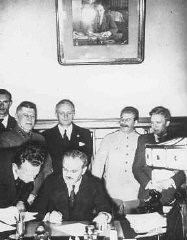
Sigrid Undset's novels were among the texts the Nazis banned and burned. Undset had previously won the Nobel Prize for Literature in 1928.
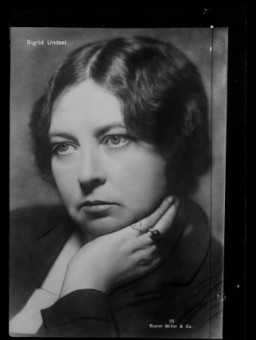
Simon Wiesenthal, Holocaust survivor and an investigator of Nazi war criminals, tours a synagogue for refugee Jews in central Europe. Place uncertain, 1946.
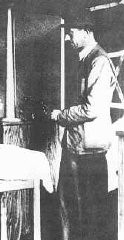
Simone Schloss, a Jewish member of the French resistance, under guard after a German military tribunal in Paris sentenced her to death. She was executed on July 2, 1942. Paris, France, April 14, 1942.
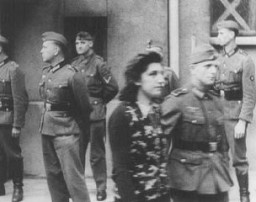
Sinaida Grussman was photographed in the Kloster Indersdorf children's center after the war. The picture was taken in an attempt to help locate surviving relatives. Such photographs of both Jewish and non-Jewish children were published in newspapers to facilitate the reunification of families. Germany, after May 1945.

Singer Simon Bikindi sits at the International Criminal Tribunal for Rwanda during his trial for incitement to genocide. Arusha, Tanzania, April 4, 2002.
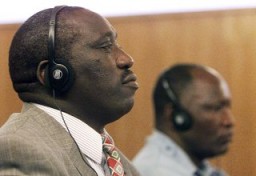
Sir Horace Rumbold was the British ambassador to Germany from 1928 to 1933. Rumbold described for the British government the changes he saw in Germany once Hitler came to power in January 1933. In a dispatch dated April 26, 1933, he warned of the principles outlined in Hitler's Mein Kampf and wrote that "the outlook for Europe is far from peaceful." Undated photograph. Library of Congress, Prints & Photographs Division, LC-DIG-ggbain-36812
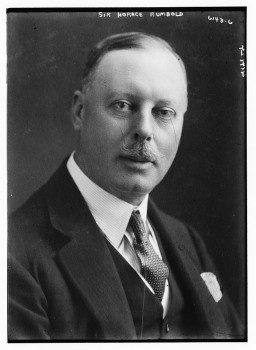
Denunciations of Jews to German authorities came from a variety of different sources, sometimes even from their "protectors." In 1944, Eva and Liane Münzer (pictured here) were reported to the police as a result of a domestic fight between their rescuers. The irate husband denounced his wife and the two Jewish girls. The Münzer sisters were sent to Auschwitz and killed.
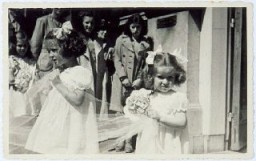
Sisters Eva and Liane Münzer. They were placed in hiding with a devout Catholic couple. In 1944, Eva and Liane were reported to the police as a result of a fight between their rescuers. The husband denounced his wife and the two Jewish girls. The three were immediately arrested and sent to the Westerbork camp. On February 8, 1944, eight- and six-year-old Eva and Liane were deported to Auschwitz, where they were murdered. Photograph taken in The Hague, the Netherlands, 1940.
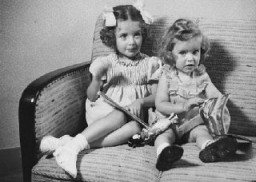
German citizens stand outside the decorated Hotel Dreesen, where Neville Chamberlain and Hitler held their second meeting on the Sudetenland and German demands for Czech territory. Nazi flags and the Union Jack fly from the building. Bad Godesberg, Germany, September 22, 1938.
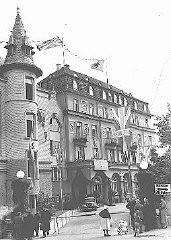
View after the obliteration of the Belzec killing center showing a railway shed where victims' belongings were stored. Belzec, Poland, 1944.
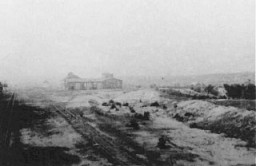
The Hotel Royal, site of the Evian Conference on Jewish refugees from Nazi Germany. Evian-les-Bains, France, July 1938.
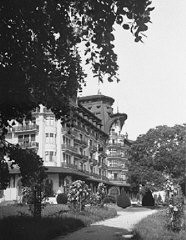
Barn on the outskirts of the town of Gardelegen that was the site of the massacre of over 1,000 concentration camp prisoners. Germany, April 16, 1945.
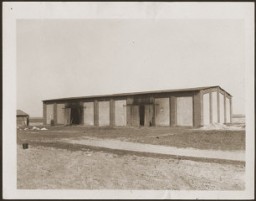
American troops inspect the site of the Gardelegen atrocity. In the background, German civilians exhume corpses who were buried in a mass grave by the SS. Germany, April 18, 1945.
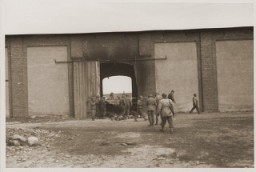
Six Jewish girls hidden from the Nazis at the Dominican Convent of Lubbeek near Hasselt. Belgium, between October 1942 and October 1944.
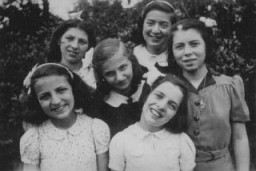
View of the six-sided skylight in the Hall of Remembrance at the United States Holocaust Memorial Museum. Washington, DC, January 2003.

Sleeping quarters in Wöbbelin, a subcamp of Neuengamme concentration camp. This photograph was taken upon the liberation of the camp by US forces. Germany, May 5, 1945.
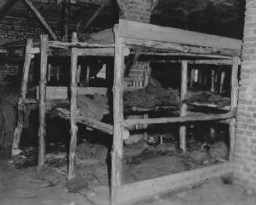
25th Nazi propaganda slide for a Hitler Youth educational presentation in the mid-1930s. The presentation was entitled "5000 years of German Culture." This slide references Lebensraum (the need for living space) in German history: "Wachsende Volkszahl im fargen Nordland zwang neuen Lebensraum zu suchen. Das innerlich morsche Römerreich bricht im Ansturm der Germanen zusammen." Translated as: "Growing numbers of people in Nordland were forced to look for a new habitat. The inwardly…

The daughter of a white German woman and a Black French soldier stands among white classmates, Munich, 1936. This image was included as a slide for lectures on genetics, ethnology, and race breeding at the State Academy for Race and Health in Dresden, Germany.

Distant view of smoke from the Treblinka killing center, set on fire by prisoners during a revolt. This scene was photographed by a railway worker. Treblinka, Poland, August 2, 1943.
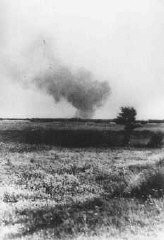
German forces during the military assault on Rotterdam during the Western Campaign. Rotterdam, the Netherlands, May 1940.
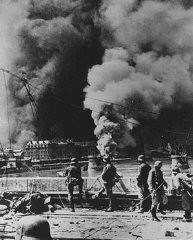
German forces and Polish civilians on the outskirts of Warsaw. In the background of the photograph, the city burns as a result of the German military assault. Warsaw, Poland, September 1939.
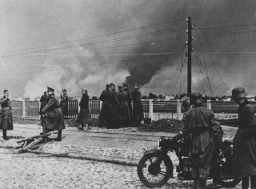
Members of a soccer team in Bitola pose in the goal of a sports field. August 14, 1928.
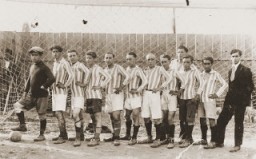
Social Democratic political prisoners in the Duerrgoy concentration camp near Breslau. Seated in the center is Paul Loebe, a leading Socialist and former president of the German parliament. Duerrgoy camp, Germany, August 4, 1933.
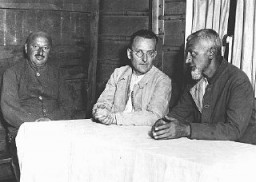
View of Solahütte, an SS retreat near Auschwitz. From Karl Höcker's photograph album, which includes both documentation of official visits and ceremonies at Auschwitz as well as more personal photographs depicting the many social activities that he and other members of the Auschwitz camp staff enjoyed. These rare images show Nazis singing, hunting, and even trimming a Christmas tree. They provide a chilling contrast to the photographs of thousands of Hungarian Jews deported to Auschwitz at the…
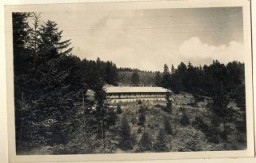
Soldiers of the Polish Home Army (Armia Krajowa) take cover behind a barricade during the Warsaw Polish uprising. During the uprising, the Home Army was supported by 2,500 soldiers from other resistance movements, such as the National Armed Forces (Narodowe Siły Zbrojne, NSZ) and the communist People's Army (Armia Ludowa, AL). Only a quarter of the partisans had access to weapons, fighting against 25,000 German soldiers equipped with artillery, tanks, and air forces. Two of the three soldiers shown here…
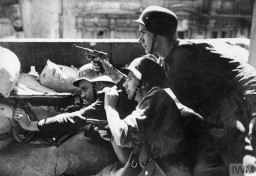
In Poznan, ethnic German recruits to the German army swear allegiance to Adolf Hitler. January 1940.
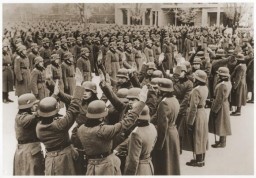
Some of the "Tehran Children," Polish Jewish refugees, study Hebrew in a Jewish National Fund youth village near Jerusalem. Palestine, March 9, 1943.
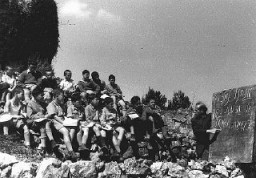
Sophie Ehrhardt, a German hygienist working with Dr. Robert Ritter, performs a racial examination on a Romani woman. Berlin, Germany, c. 1936-1940. During the Nazi era, Dr. Robert Ritter was a leading authority on the racial classification of people pejoratively labeled “Zigeuner” (“Gypsies”). Ritter’s research was in a field called eugenics, or what the Nazis called “racial hygiene.” Ritter worked with a small team of racial hygienists. Among them were Eva Justin and Sophie Ehrhardt. Most…
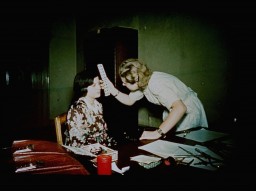
Dr. Sophie Turner-Zaretsky, Space Shuttle Discovery Commander Mark Polansky, and United States Holocaust Memorial Museum chief of staff Bill Parsons. They are holding a replica of "Refugee" bear and a photo of a Darfurian child refugee, items taken by Commander Polansky on a December 2006 Space Shuttle mission.
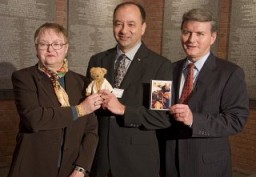
Women and children gather at the door of a soup kitchen maintained by the American Jewish Joint Distribution Committee. The text in Yiddish reads "The fortunate ones with full bowls." Zelechow, Poland, 1940.
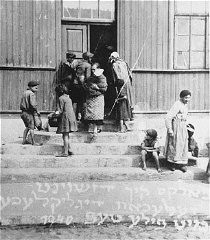
Soviet planes fly over the destroyed Reichstag (German parliament) building in Berlin. Photograph taken by Yevgeny Khaldei. Berlin, Germany, ca. April 1945.
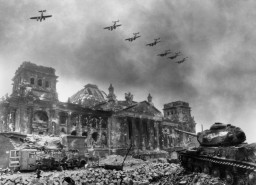
Photograph from a series taken by a guard in the Soviet prisoner-of-war camp of Belzen bei Bergen, and numbered in Roman numerals by the American officer, Lt. van Otten. The camp held approximately 10,000 POWs, most of whom came from Fallingbostel, 10 km away. When they fell ill, they were marched to Belsen. At Belsen, they were starved, often given only a soup made of field beets. This photo shows Soviet POWs assembled at the camp. Germany, 1941–45. Second only to the Jews, Soviet prisoners of war…
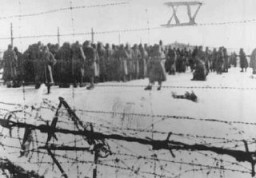
Soviet prisoners of war in the Mauthausen concentration camp. Austria, January 1942.
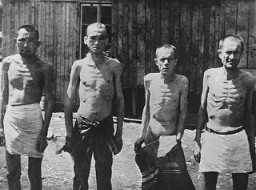
Columns of Soviet prisoners of war. Soviet Union, September 15, 1942. Second only to the Jews, Soviet prisoners of war were the largest group of victims of Nazi racial policy.
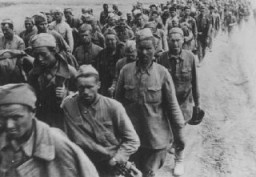
Soviet prisoners of war arrive at the Majdanek camp. Poland, between October 1941 and April 1944.
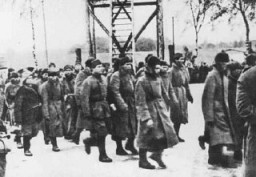
German soldiers force Soviet prisoners of war to construct a rail line. Place uncertain, 1941-1942. This photograph is from an album discovered in a search mission in an abandonend building near Nuremberg by Steven Imburgia while serving with the 633rd Anti-Aircraft Unit.
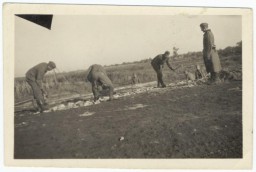
Soviet prisoners of war at forced labor build a road. Probably in the Soviet Union, about 1943.
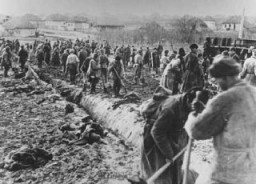
Soviet prisoners of war, survivors of the Majdanek camp, at the camp's liberation. Poland, July 1944. Second only to the Jews, Soviet prisoners of war were the largest group of victims of Nazi racial policy.
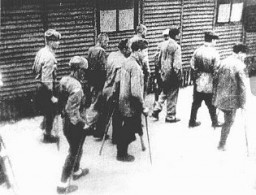
SS officers posing in front of a newly arrived transport of Soviet prisoners of war. Mauthausen concentration camp, Austria, 1941.
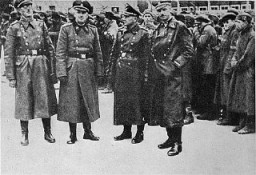
Soviet prisoners of war receiving their meager rations. More than three million Soviet prisoners of war died in German custody, mostly from malnutrition and exposure. Rovno, Poland, 1941. Second only to the Jews, Soviet prisoners of war were the largest group of victims of Nazi racial policy.
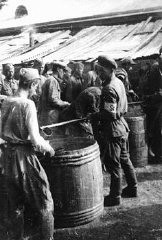
We would like to thank Crown Family Philanthropies, Abe and Ida Cooper Foundation, the Claims Conference, EVZ, and BMF for supporting the ongoing work to create content and resources for the Holocaust Encyclopedia. View the list of donor acknowledgement.